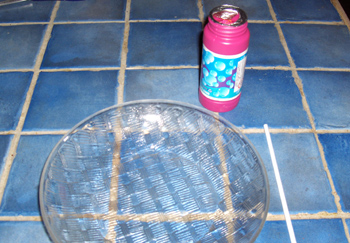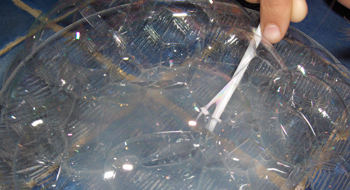
Step 1: Soap please
Place some liquid soap in a deep plate.
Step 2: Make a bubble
Dip the straw into the liquid and gently blow through it to create a bubble.
Step 3: Watch it
Look at the bubble's colours as you blow. Stop blowing for a moment and quickly place your thumb on the end of the straw while you study the bubble from different angles.

Step 4: It's going to pop!
Here, the goal is to observe the colour change that takes place just before the bubble pops. Go ahead, blow gently.
Explanation
The thickness of soap film varies from 0.01 micron to 1 micron (10,000 to 100 times thinner than a sheet of paper). Its thickness is greater at the base of the bubble due to gravity. The light absorbed by a soap bubble is reflected and splits into various colours depending upon the thickness of the film. Because the surface is thin, there is a lot of interference between the light absorbed and the light reflected, creating iridescence. When the upper part of the bubble becomes very thin, the interference prohibits the light from exiting and dark colours appear. This is a bit like what happens when a hummingbird is no longer in the angle of light, interference cancels the light from exiting and the bird's throat appears dark-coloured.
Variations
You can observe iridescence by placing a thin film of oil on water or by studying a CD, DVD or paper money. Iridescence is a way of inspecting bills for counterfeiting.
|